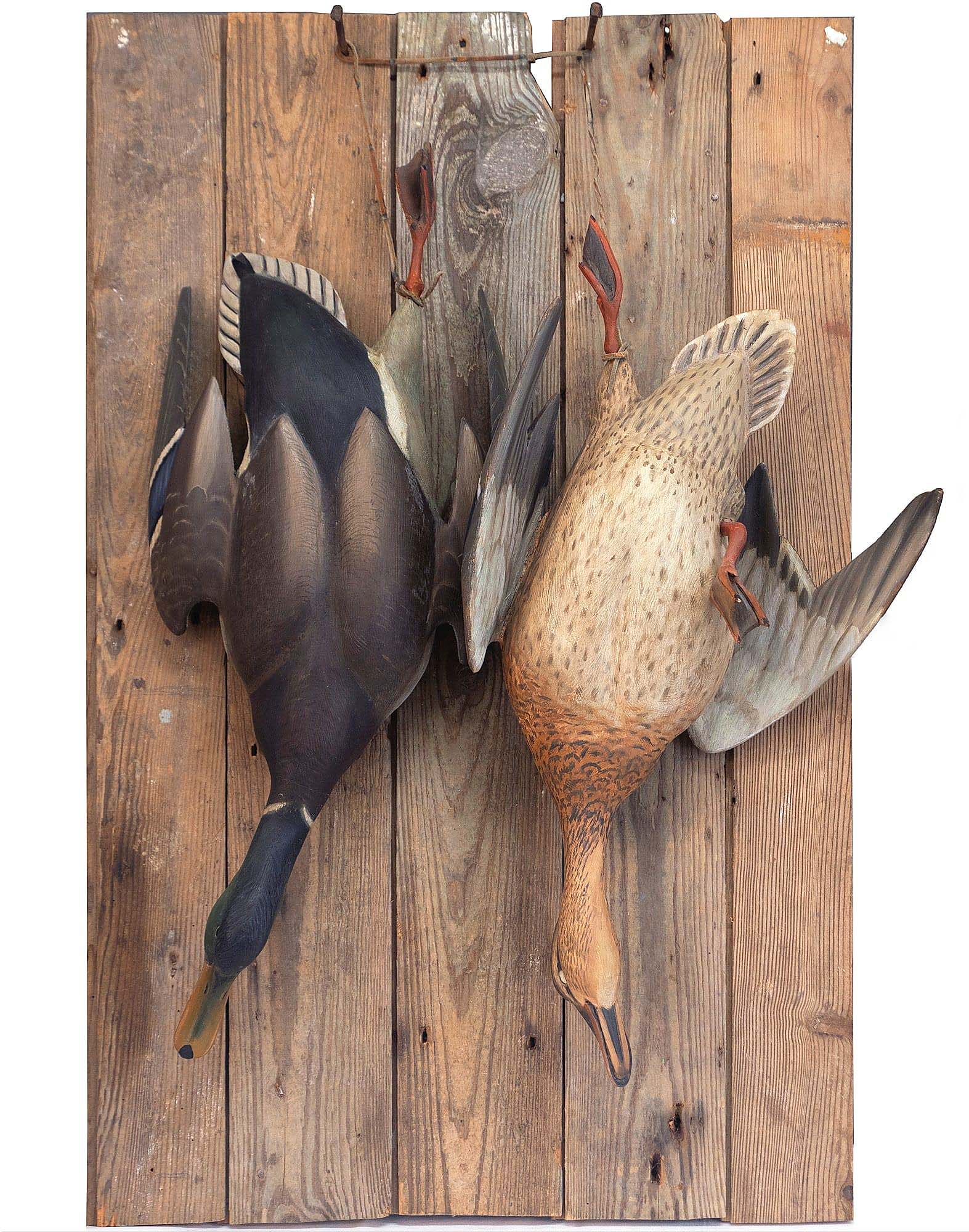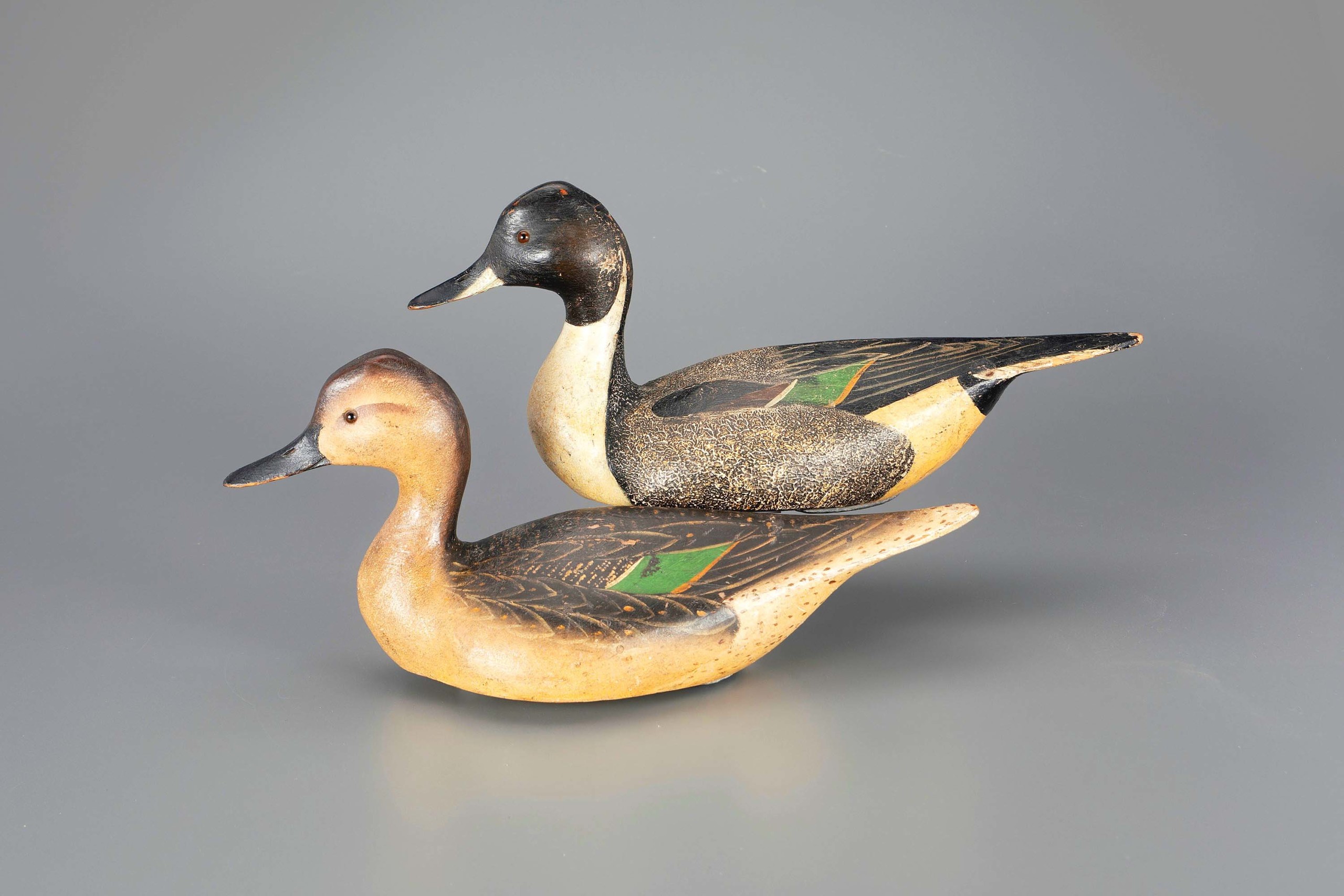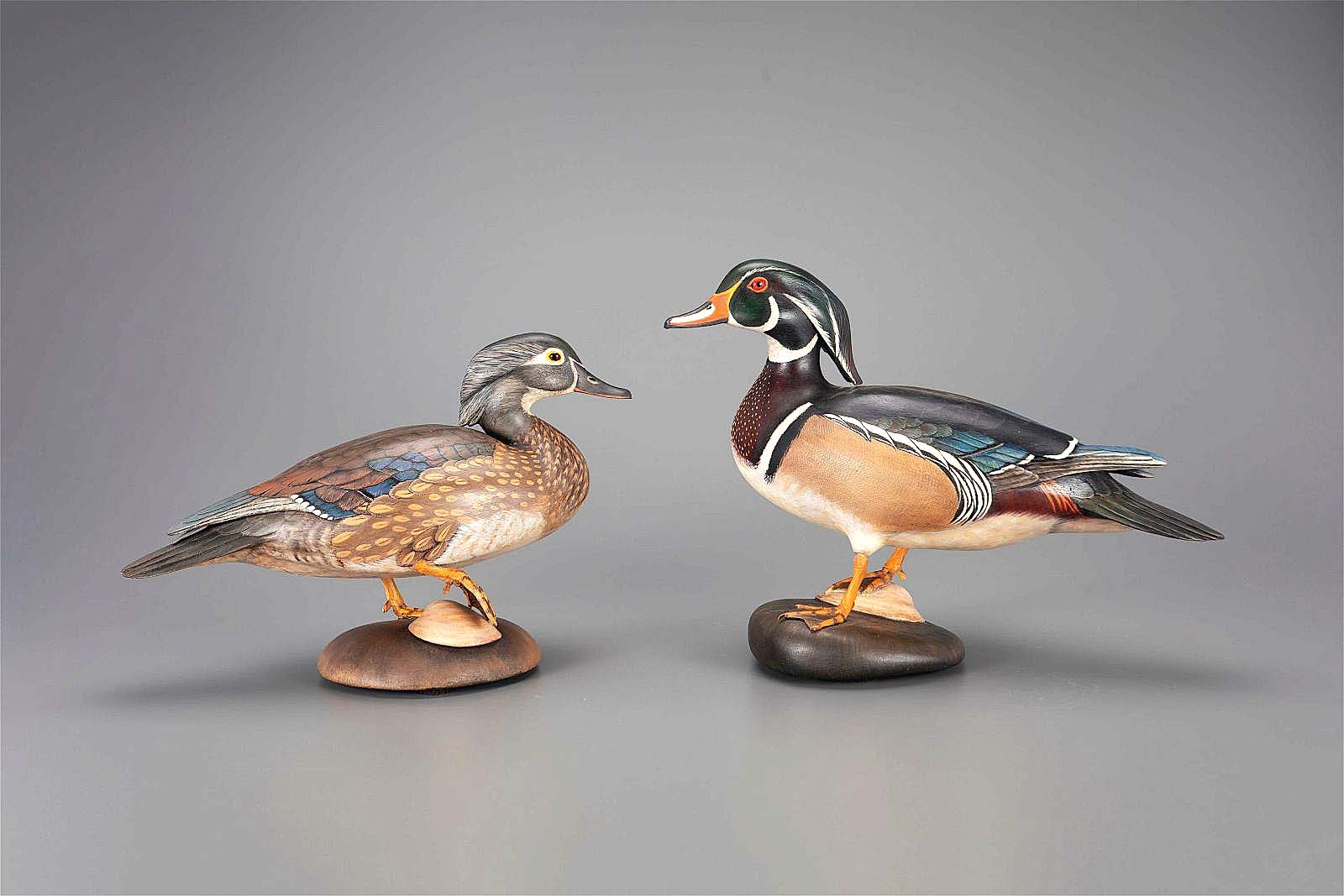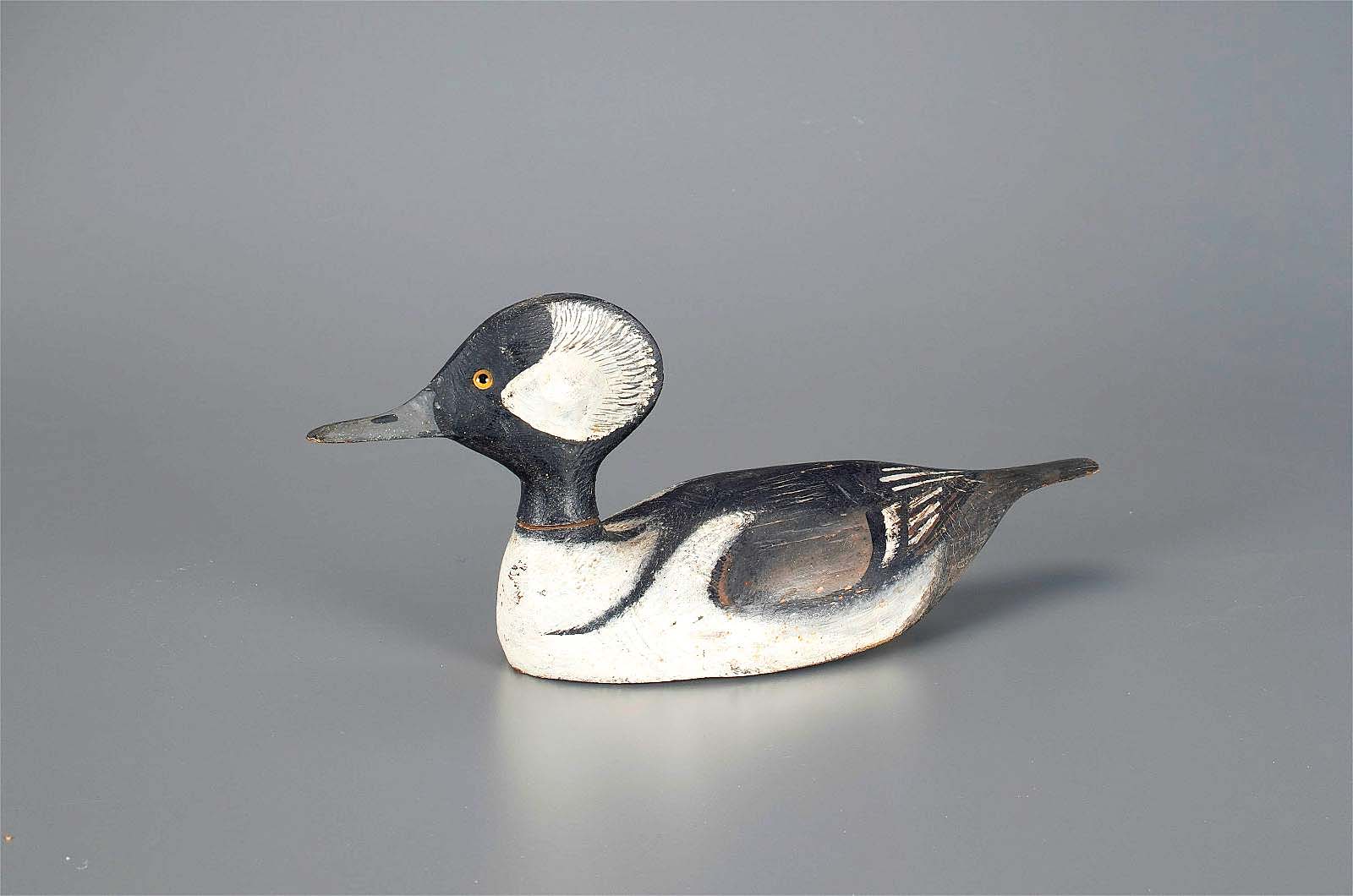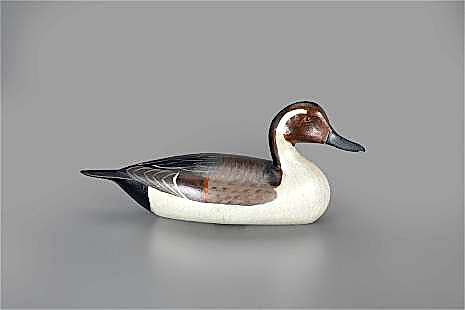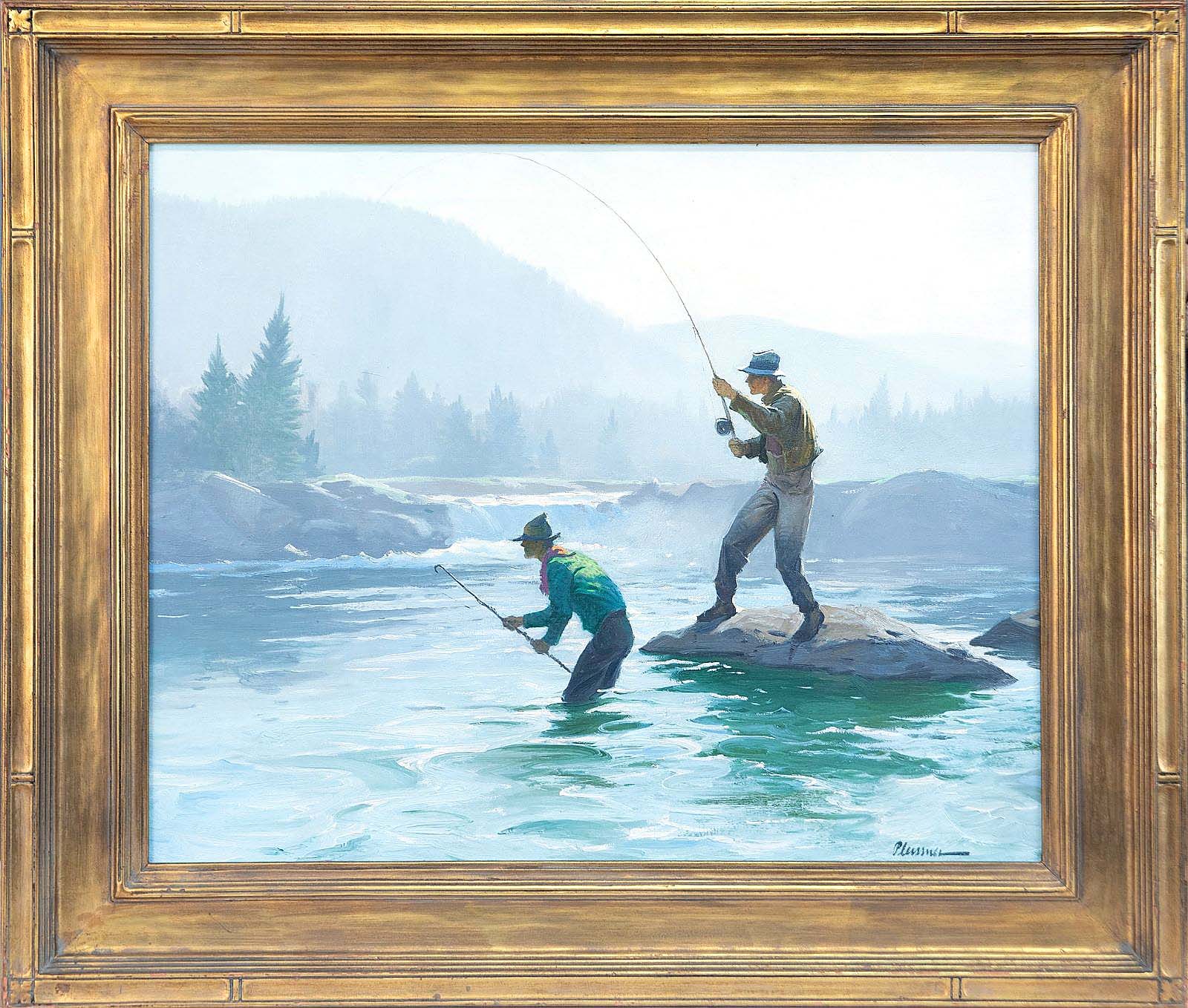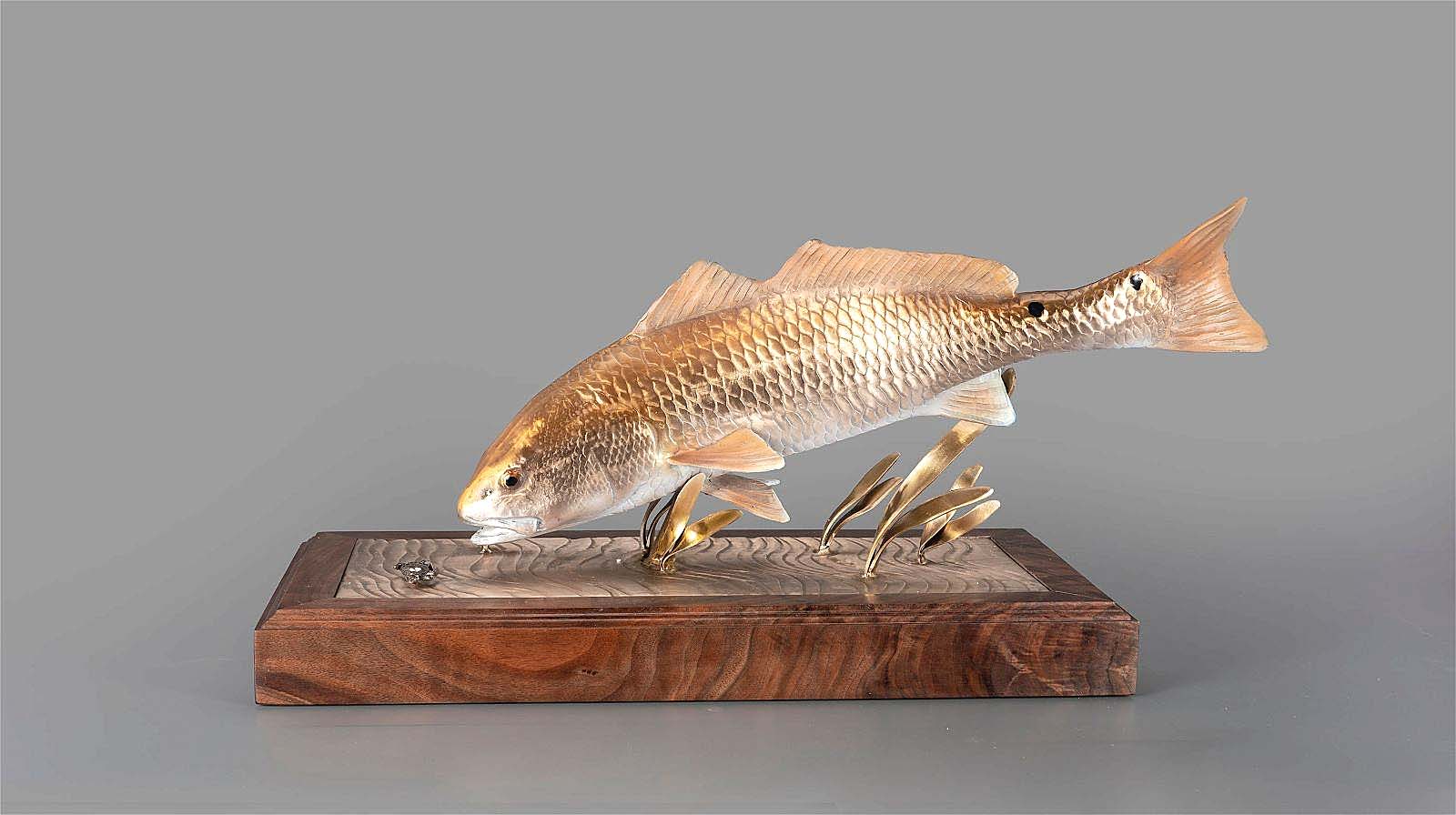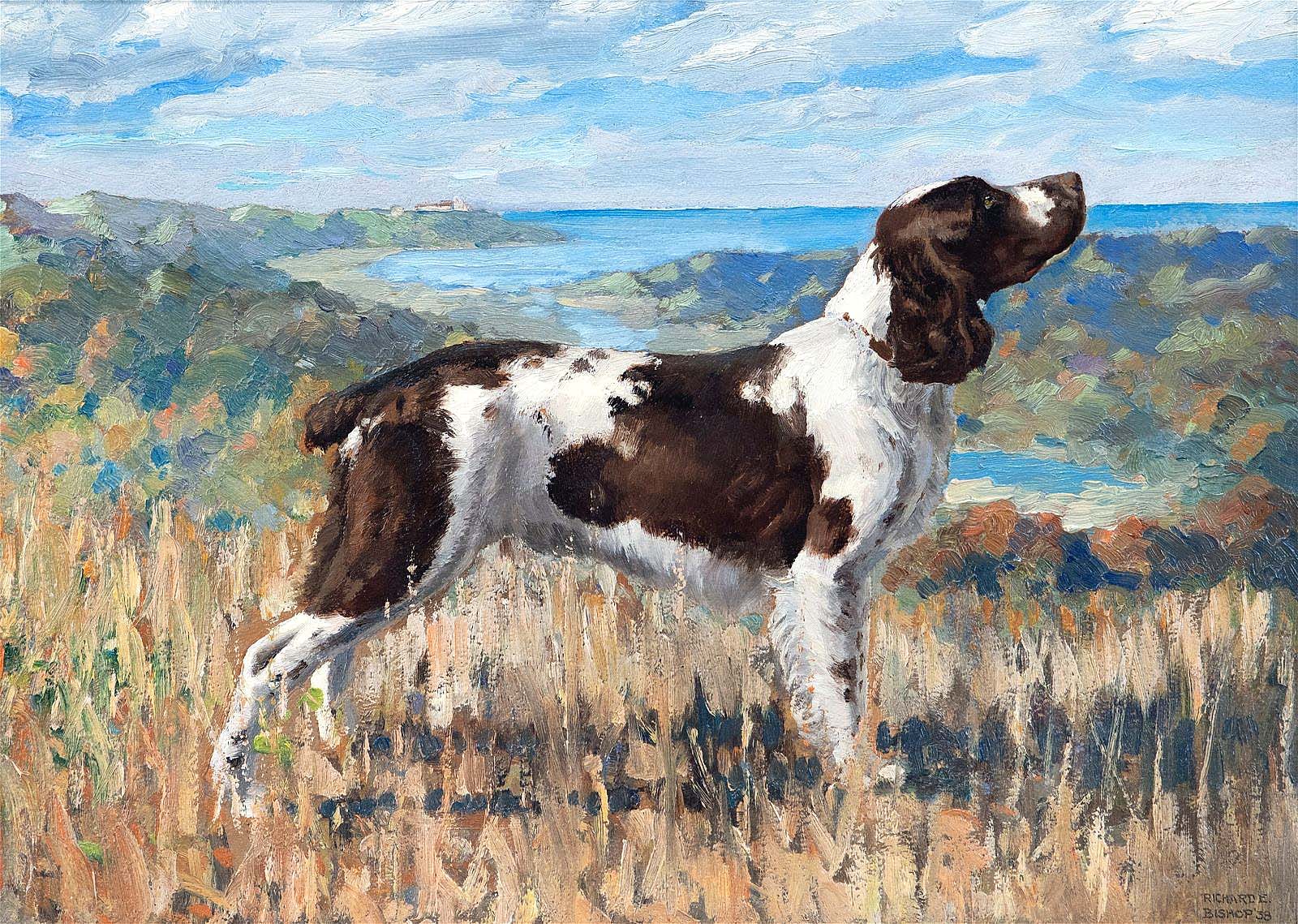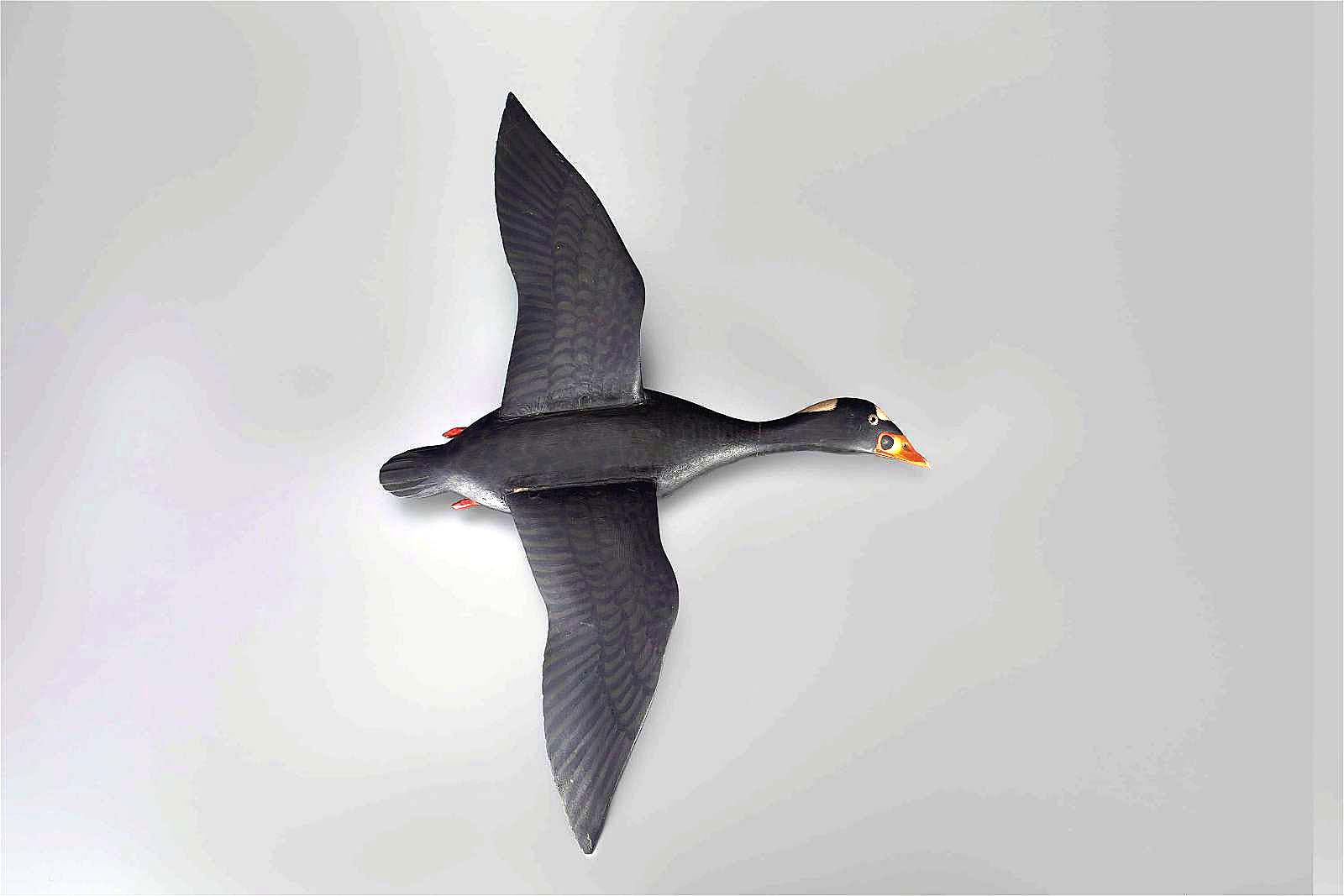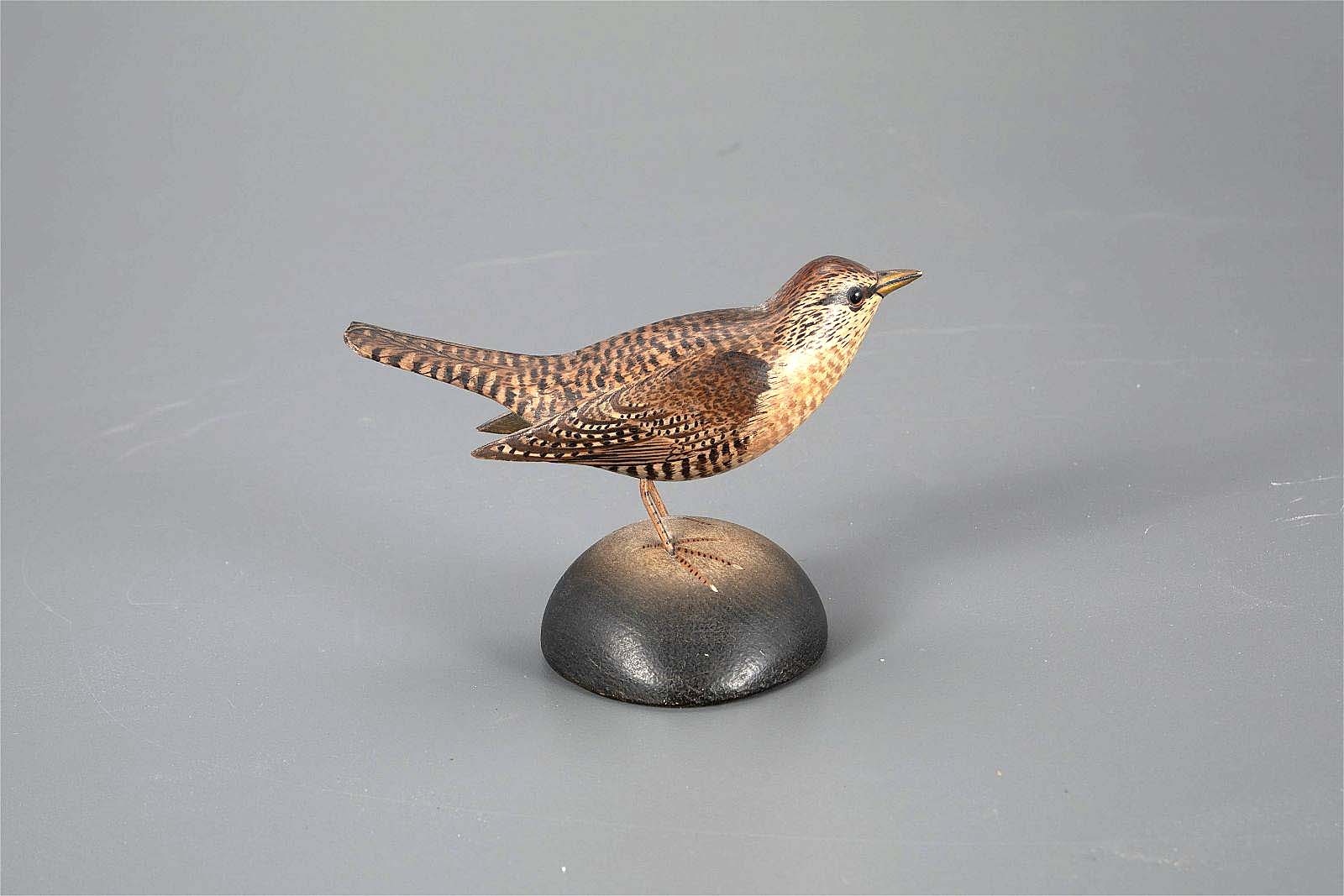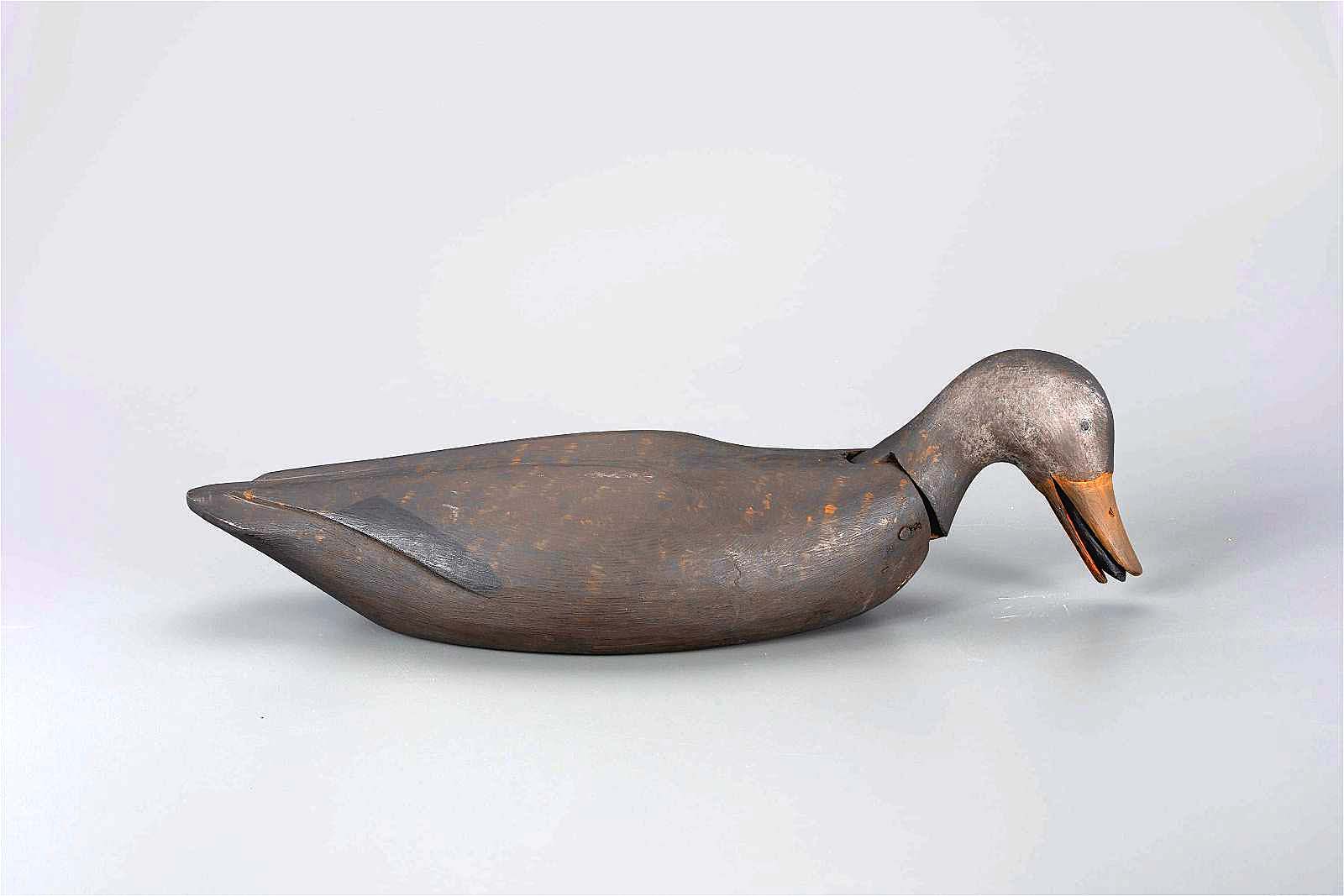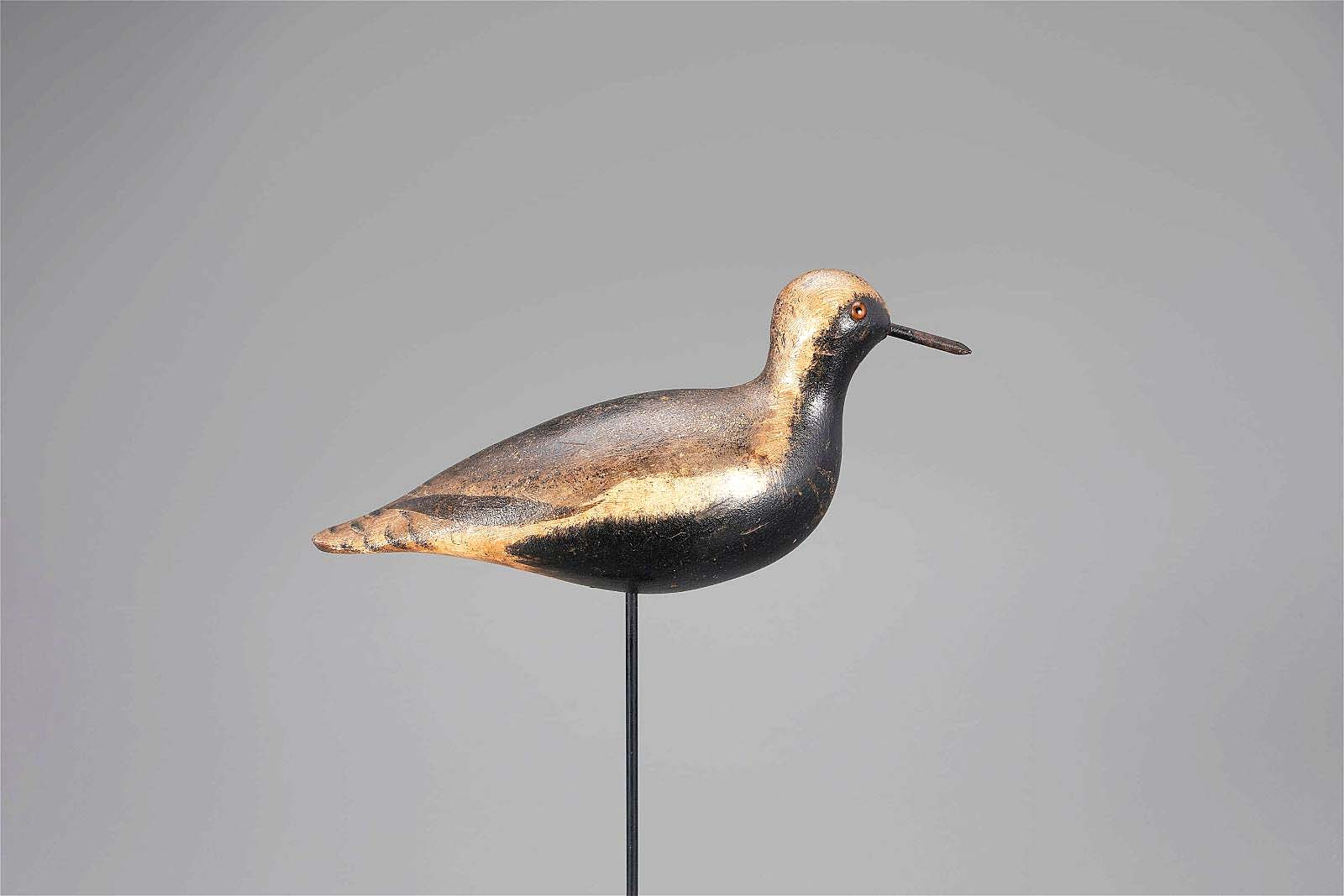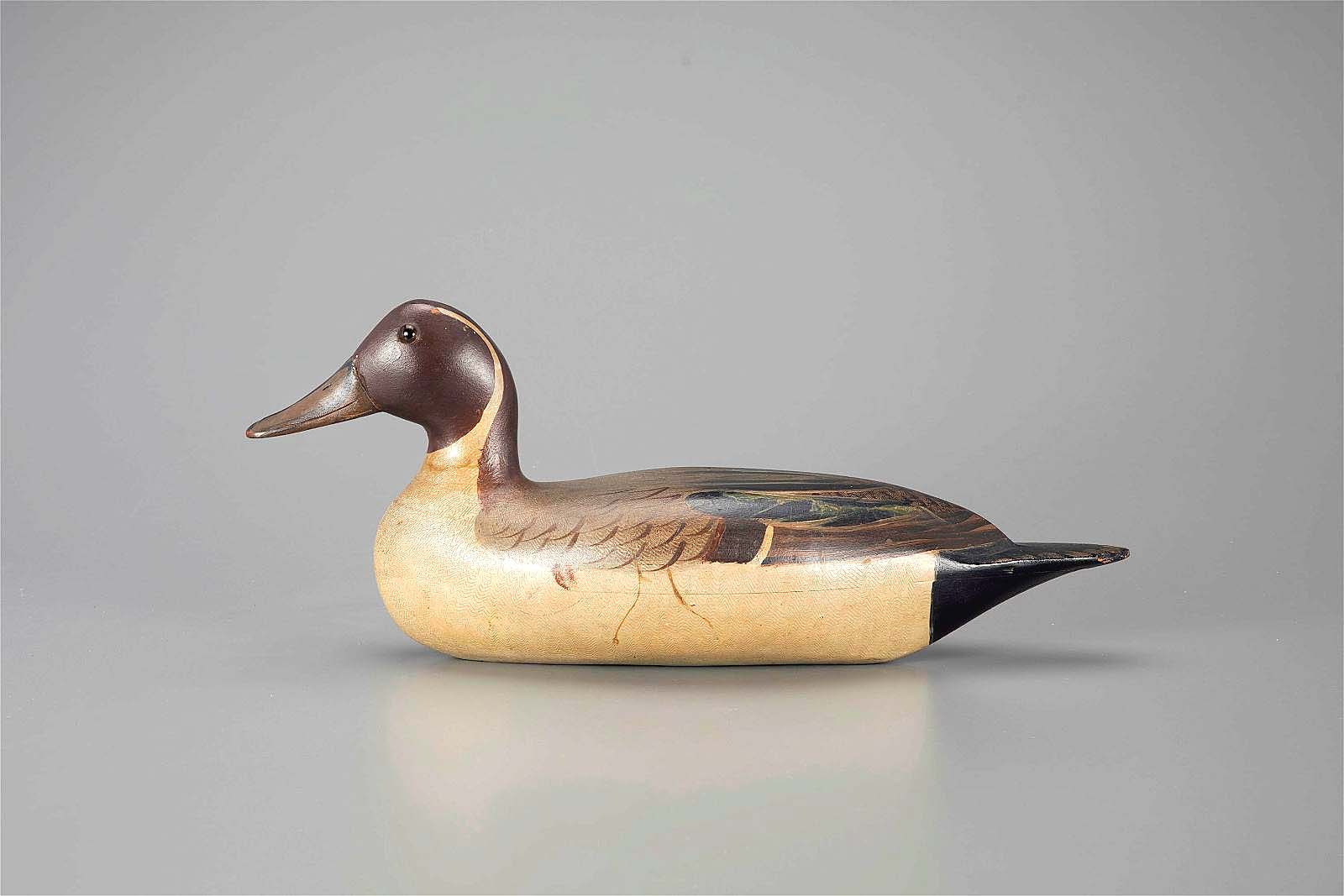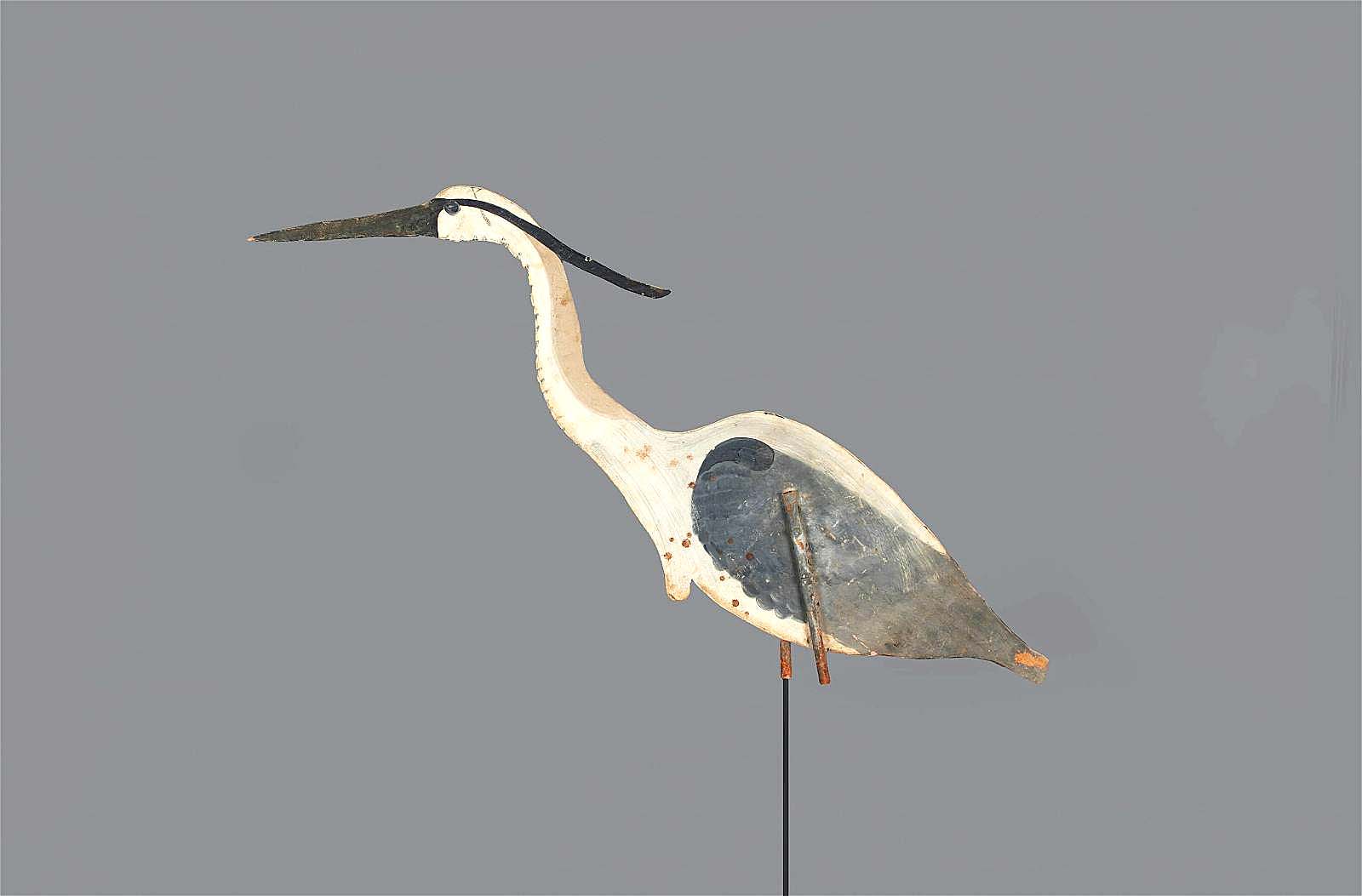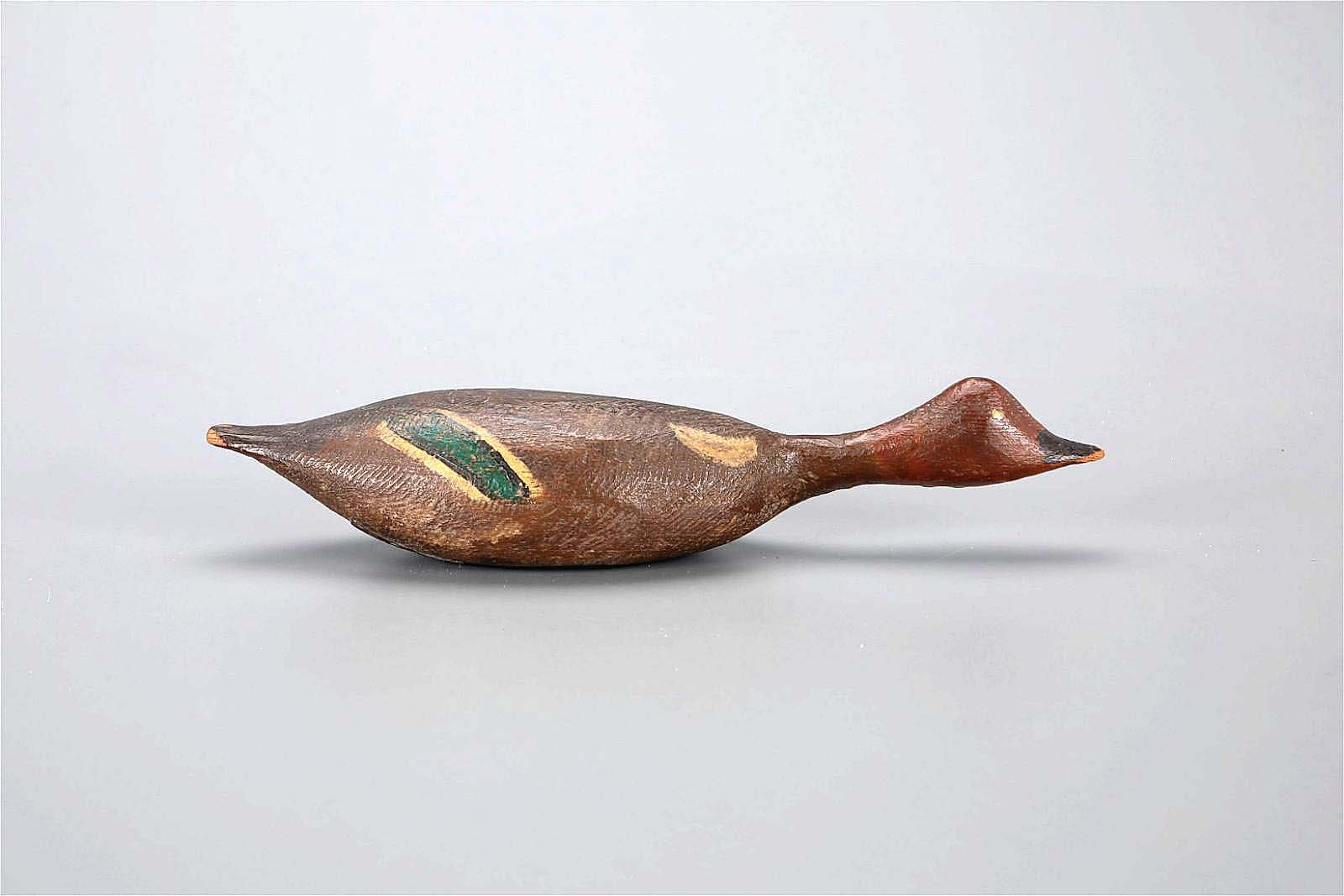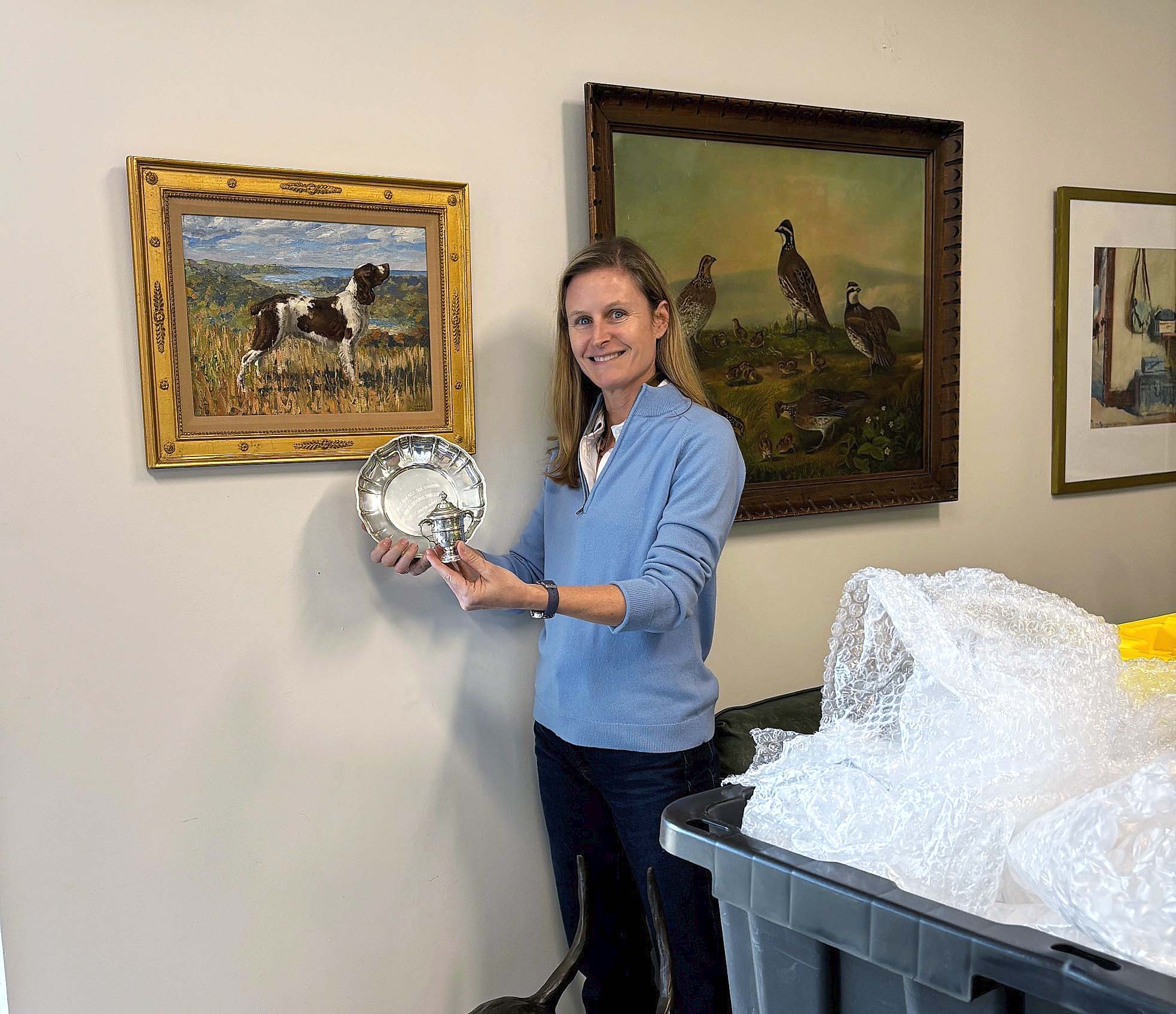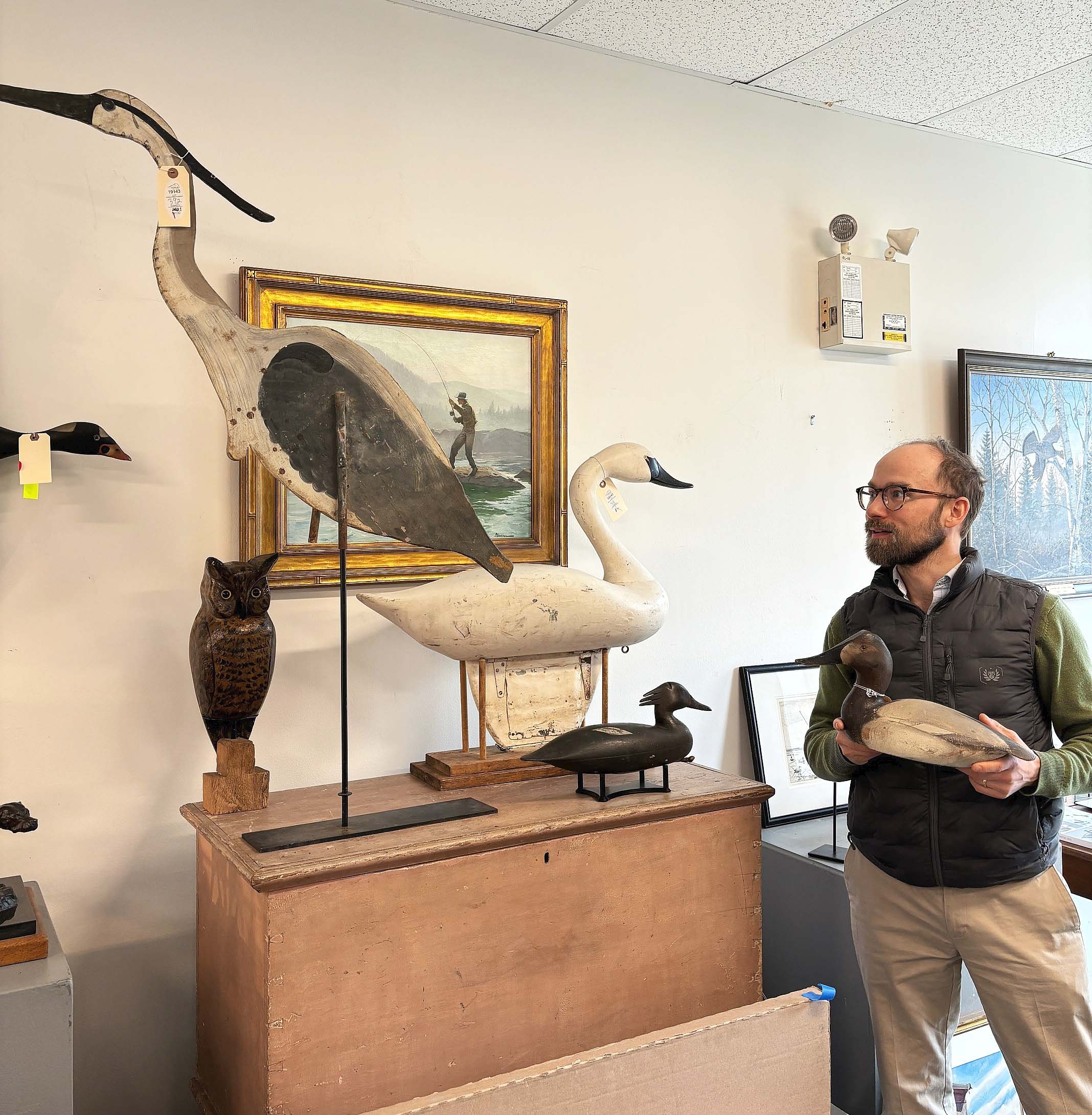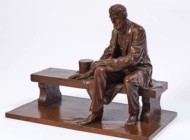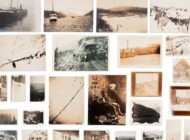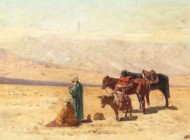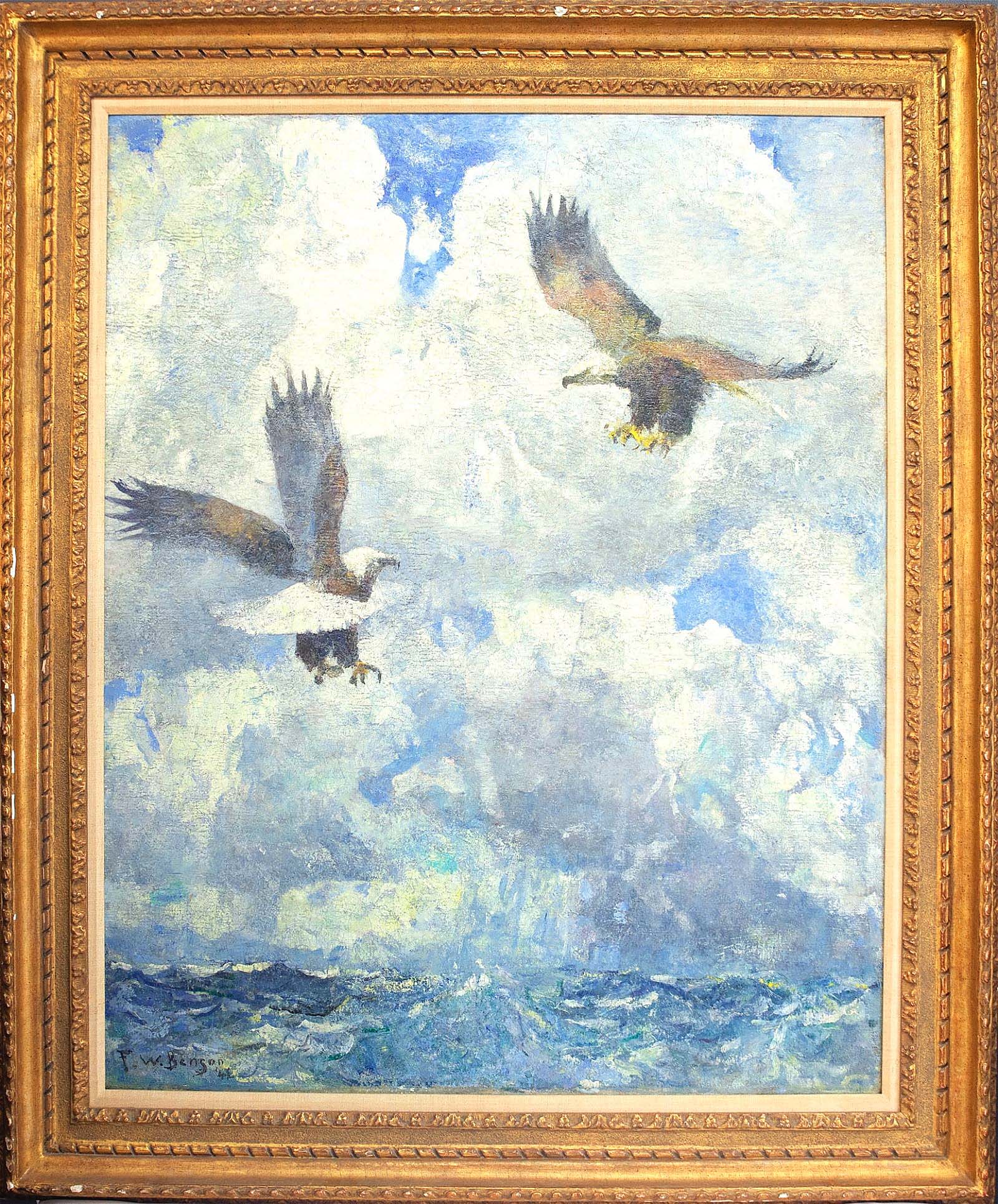
Selling for $210,000, Frank Benson’s “Bald Eagles (The Eagles)” was the highest priced item in the sale. It had descended in the family of the artist.
Review & Onsite Photos by Rick Russack; Catalog Photos Courtesy Copley Fine Art
HINGHAM, MASS. — Stephen O’Brien’s Copley Fine Art Auctions began its 2024 auction season with a collection of paintings and etchings directly from the family of artist Frank Benson, a pair of important Ward Brothers pinch-breast pintail decoys, a selection of rarities that were part of the Tom Figge collection of “Masterworks of The Illinois River” and much more. The highest priced lot of the sale was a 1941 oil on canvas, “Bald Eagles (The Eagles),” by Frank Benson which sold for $210,000. Topping the decoy selection, the pair of pinch-breast Ward Brothers pintails, earned $211,200 although they were sold separately. Another Benson painting earned a six-figure price and more than 30 other lots brought five figure prices. There was much more to the sale, including decoys by Elmer Crowell, Gus Wilson, Joe Lincoln, Charles Perdew and others. There was an extensive selection of quality West Coast decoys and contemporary carvings. The selection of sporting art included paintings by Ripley, Hunt and others. When taken together, the sale banked a total of $2,250,000.
Copley’s marketing of the carvings and sporting art included exhibiting several items at the Eastern Shore of Virginia Decoy Show and, the weekend before the sale, at the Southeastern Wildlife Exposition in Charleston, S.C., which draws approximately 40,000 visitors. Their 250-page catalog included information on the carvers, provenance, condition, literature citations if the decoys has been exhibited or included in previous publications, and numerous color photographs.
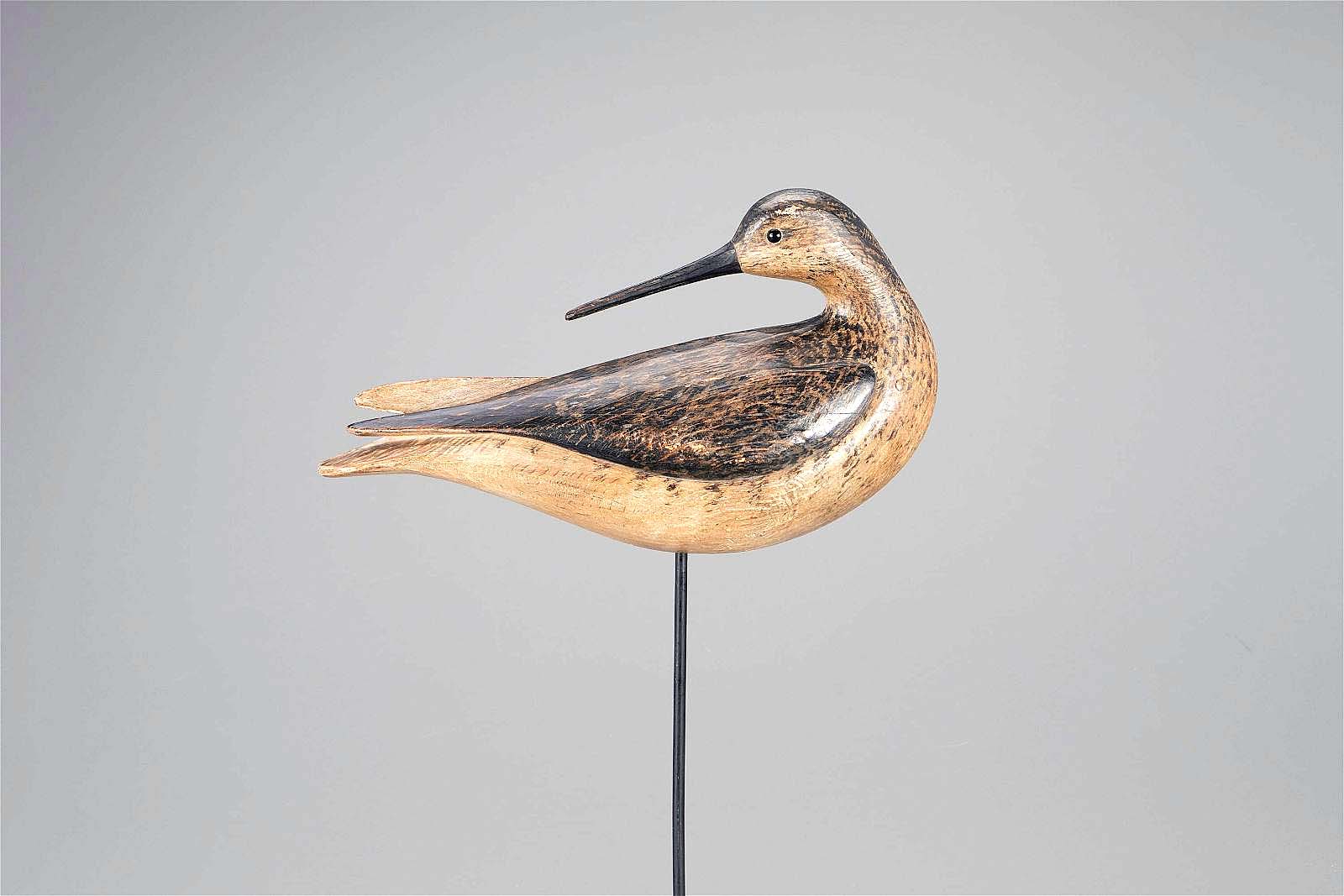
The sale began with a selection of contemporary carvings, including 11 by Mark McNair. This circa 1980 preening Willet earned $9,000, the highest price of that selection.
Prior to the sale, O’Brien expressed his thoughts on collecting decoys and sporting art, but was worth applying much more broadly. “I have long felt that the art objects we want to possess are a window into our souls. We search and mine for pieces that resonate — a painting of a secluded bonefish flat, a setter holding the perfect point frozen in time in bronze, a decoy that reminds us of our first duck hunt. Entering the collecting realm is a bit like crossing the threshold of the mythical Hotel California: ‘You can check out any time you like, but you can never leave.’ The collecting bug can bite so deep that it becomes a part of our very being. We hope that the next generation of caretakers will feel the same way about our beloved objects or at the very least respect our efforts. Collecting has given me a better understanding of history and introduced me to some of my best friends. I wish everyone a long river of collecting, filled with all of its fun twists and turns.”
Sold early in the sale, the important pair of pinch-breast pintail decoys carved by the Ward Brothers of Crisfield, Md., had a distinguished provenance, having once belonged to singer Andy Williams (one of his mega-hits was “Moon River” from Breakfast at Tiffany’s). Williams bought the pair at a Richard Bourne auction of part of the William Mackey collection in October 1974, where it was the top priced lot. Twelve years later, Williams consigned them to another Bourne sale, where again they brought the highest price of the sale and were purchased by Ronald Gard, who later wrote Ward Brothers’ Decoys: A Collector’s Guide. (Gard and his recent book, Whose Dog Are You? were the subjects of a Q&A in the February 23 issue of this publication.) At each of the previous sales, the drake and hen had been sold together, as one lot. Copley elected to offer the drake and hen separately. The drake sold for $108,000 while the hen brought a little less: $103,200. Happily, they will be staying together as the same bidder bought them, spending $211,200. These decoys, although made on the East Coast, were hunted over by members of the White Mallard Club, an exclusive hunting club on the freshwater marshes of California’s Sacramento Valley. Ward Brothers decoys were sold by Abercrombie & Fitch, so they had wide distribution.
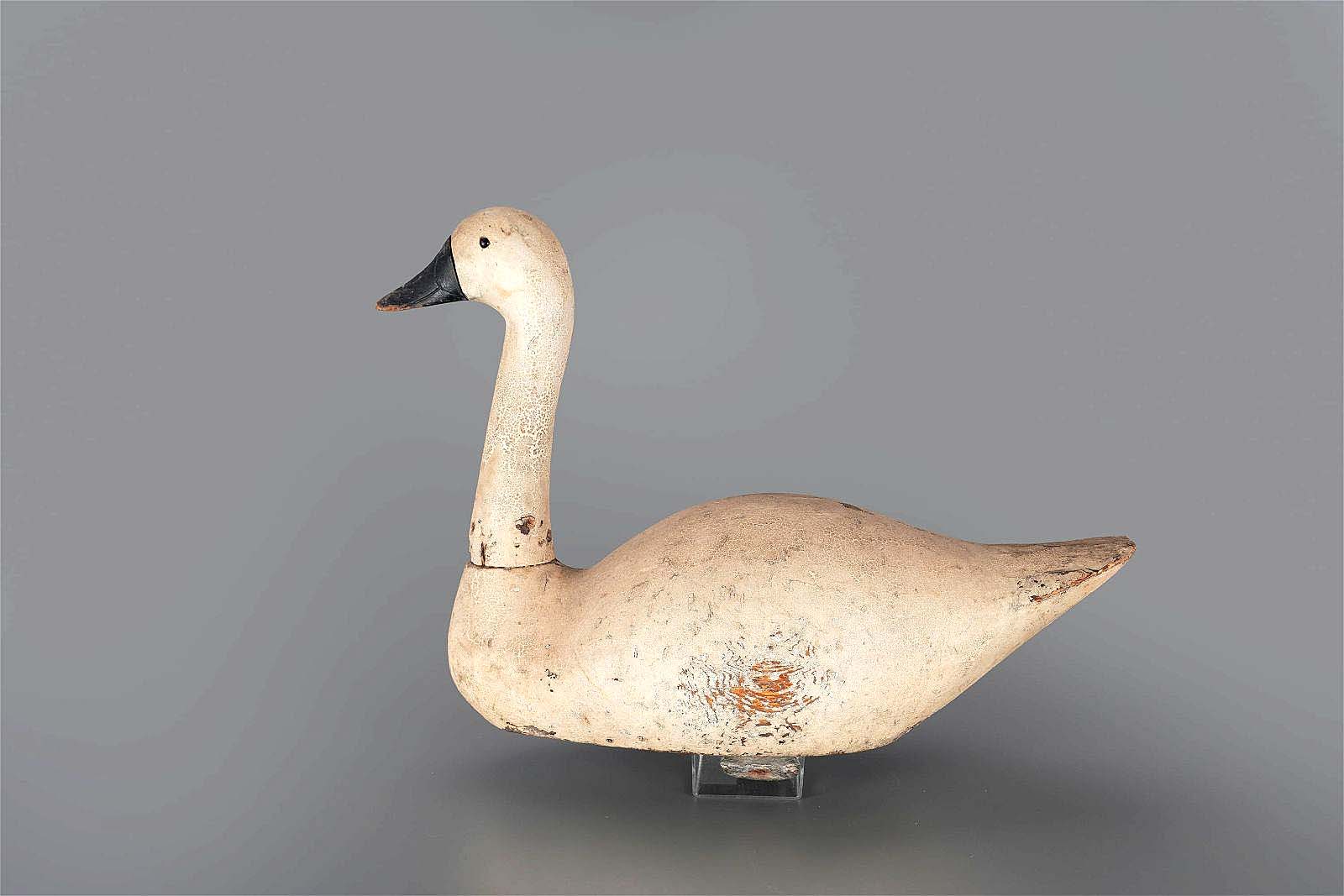
A “dust jacket” swan made by the Mason Decoy Factory, circa 1910, realized $63,000. It had been in the Alan Haid collection and was pictured on the dust jacket of an expanded version of Mason Decoys, the book Haid and Russ Goldberger wrote on the Mason birds.
The next highest price for a decoy was $63,000. It was a “dust jacket” swan made by the Mason Decoy Factory, circa 1910. It had been in the Alan Haid collection and was pictured on the dust jacket of an expanded edition of Mason Decoys, the book Haid and Russ Goldberger wrote. The decoy was discovered in a shack on Chesapeake Bay in the 1960s and, for 20 years, was on long-term loan to the Havre-de-Grace Decoy Museum. The Mason Decoy factory was in business from 1896 to 1924 and produced decoys in multiple grades, depending on carving details and paint. This swan was of their highest grade: Premier.
There’s no doubt that Elmer Crowell is one of the most respected, popular and collectable carvers, having turned out a large number of working decoys as well as exceptional, realistic miniatures and decorative carvings. Brian Cullity, writing in the Songless Aviary, said, “His (Crowell’s) working decoys from the 1900-1915 period show a degree of love, labor and art that is unparalleled in the decoy world.” A 300-page book, Elmer Crowell: Father of American Bird Carving by Stephen O’Brien Jr and Chelsie Olney was published in 2019 and is available from Copley. This heavily illustrated book, in addition to being a comprehensive discussion of Crowell’s work, is also a history of American duck hunting and the conservation movement. An unusual life-size flying surf scoter, with a 30-inch wingspan, made about 1915, led the Crowell selection, selling for $20,400, more than twice the estimate. Not far behind was a dropped-wing life-size wren, which sold for $19,800. In all, there were about 10 Crowell carvings in the auction.
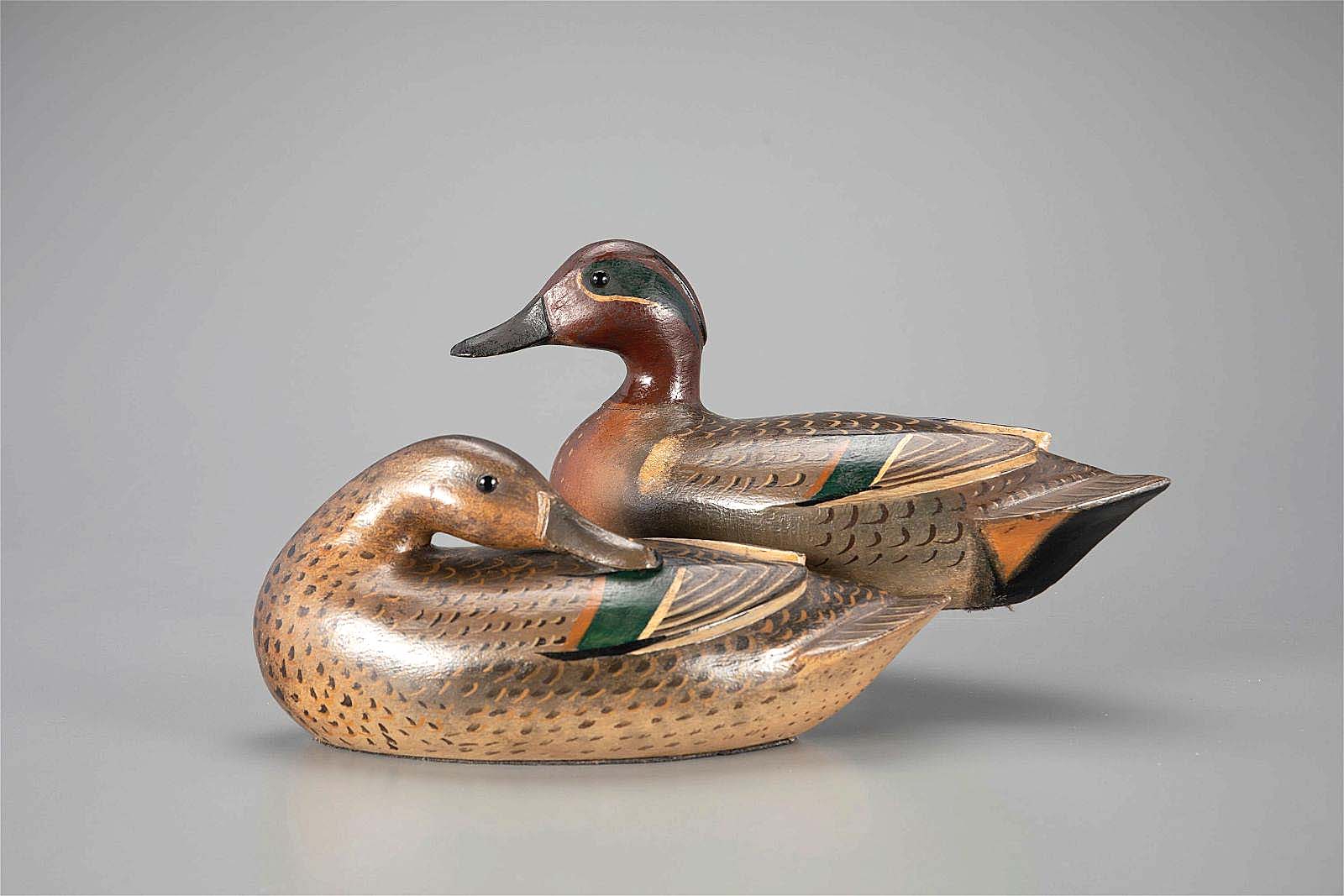
Several of the decoys in this sale were from the Masterworks of the Illinois River Collection which was first exhibited in 2005 at the Ward Museum of Wildfowl Art. This pair of green-winged teal decoys by Charles Perdew with a preening hen, created about 1945, sold for $32,500.
A portion of the collection of Illinois River decoys had been exhibited in 2005 at the Ward Museum of Wildfowl Art. Another portion of the collection is currently on exhibit at the Peoria Riverfront Museum, titled Masterworks of the Illinois River: The Collection of Thomas K. Figge. (The museum has a video of this collection currently on YouTube). O’Brien, together with Julie Carlson, wrote the heavily illustrated 153-page catalog for the 2005 exhibit in which O’Brien said, “It represents one man’s 25-year quest to obtain the greatest Illinois River decoys ever made.” The Illinois River flyway area produced many fine carvers such as Charles Perdew, Robert Elliston and Bert Graves. It was close to Chicago, providing a lucrative outlet for market gunners and it was also close enough that many wealthy residents of that city hunted at the exclusive clubs along the river. It’s not surprising, therefore, that numerous exceptional decoys were produced in the region. Topping the selection offered in this sale, realizing $41,250, was a circa 1928 pintail drake carved by Charles Perdew and painted by his wife, Edna. The two almost always worked together. A pair of green-wing teal decoys by the same carver realized $32,500. A mallard hen carved by Robert Elliston realized $20,000. Both Elliston’s wife, Catherine, and Edna Perdew painted Elliston’s carvings.
Copley’s sales include a strong selection of sporting art: paintings and sculpture. This time, there were almost 60 paintings and limited-edition etchings by Frank Benson (1862-1951), many of which had descended in his family. One of those, “Bald Eagles (The Eagles),” an oil on canvas signed and dated 1941, earned the highest price of the sale. Another of his oils, “Souvenir of Florida,” signed and dated 1934, brought $168,000. A watercolor of a room at his gunning camp in Eastham, Mass., “Interior, Mud Room,” signed and dated “F.W. Benson ‘24” sold for $16,800. There were many other paintings such as an oil on canvas, “Blue Winged Teal” by David A. Maass (b 1929), that depicted a flock of seven teal taking off from a marsh; it brought $21,500. Few of his works depict teal, making this a desirable example of his work. “Fooled on the Flats” by Luke Frazier (b 1970), which shows three bonefish converging on a fly, sold for $13,200. Al Barnes’ (1937-2015) “A Meeting at the Point” was a tranquil marine scene of blue water, a small sandy island under a blue sky with a few clouds. In the distance, a fisherman could be seen. Its final price was $19,800.
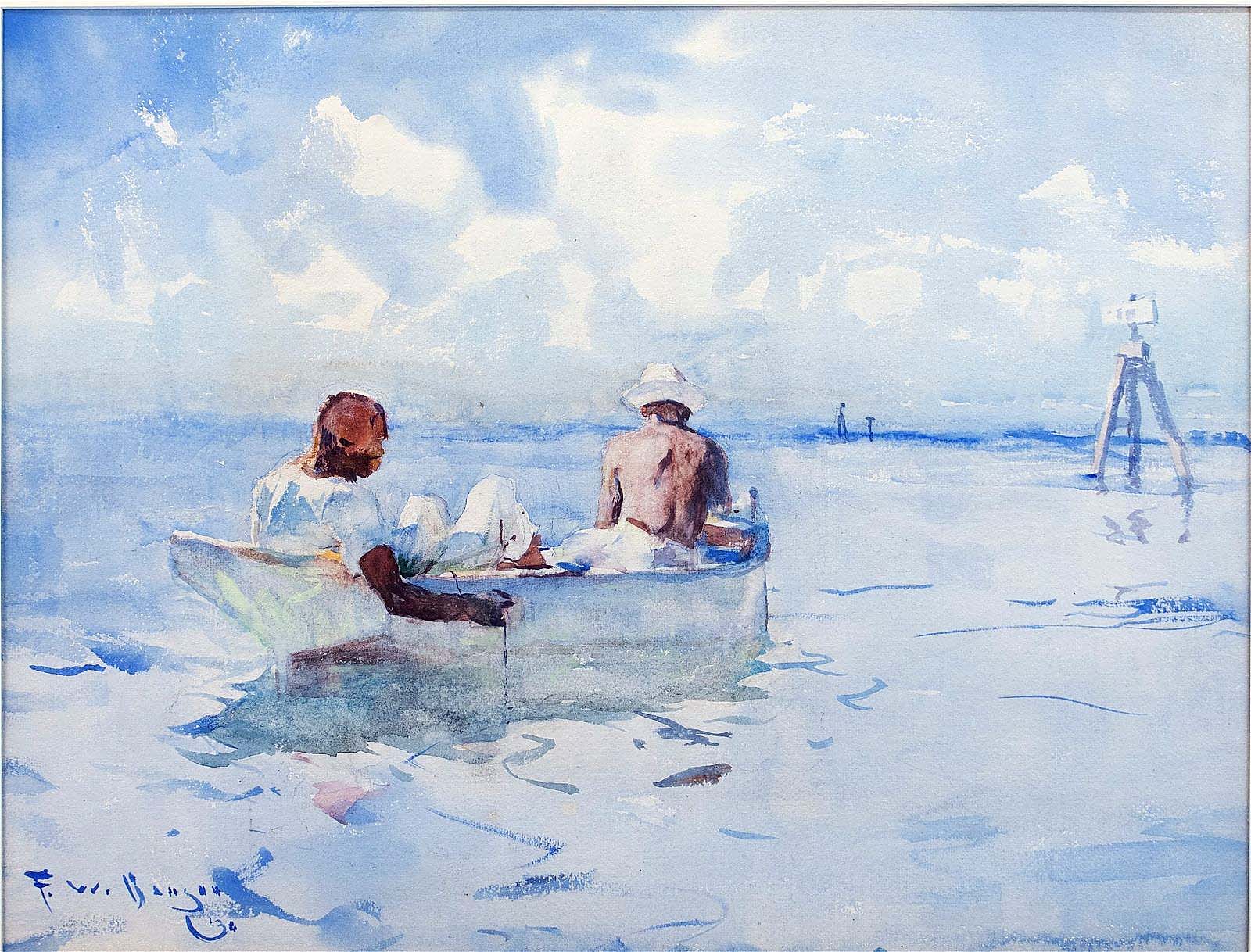
Frank Benson scholar and descendent Faith Andrews Bedford wrote about “Souvenir of Florida,” “Painted (in 1938) while on a fishing trip to the Florida Keys, this watercolor captures the sultry, shimmering heat of noonday.” It earned $168,000, the second highest price of the sale.
After the sale, O’Brien said, “This was an exciting auction as we continued to see new bidders participating at all levels, which demonstrates the stability of the market in most sectors. Despite the murmurs that continue in the six-figure decoy market, first-rate Ward brothers, Illinois River, Mason and West Coast decoys ruled the day on the decoy front. It was also great to see the recently overlooked Benson painting market starting to show some signs of life.”
Prices quoted include the buyer’s premium as state by the auction house. For additional information, 617-536-0030 or www.copleyart.com.

